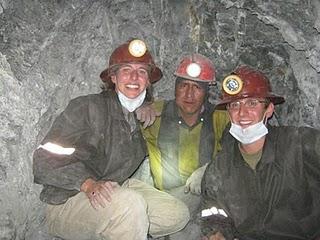Nach einer ziemlich holprigen Fahrt im Bus sind wir in Potosi angekommen. Die erste Bleibe war wortwoertlich ein "Griff id Schiissi". Das ganze Hotel roch nach Kloake und das Zimmer nach Lack. Haben am naechsten Tag schnurstracks ausgecked und uns eine neue Bleibe gesucht.
Potosi ist gepraegt von alten Kolonialbauten. Das Staedtchen hatte ihre Bluetezeit im 17 Jahrhundert als die Spanier pures Silber aus den Minen holten. Die Stadt war damals groesser als London oder Paris. Es wird auch heute noch in den Minen gearbeitet denn es hat immer noch Mieralien wie Blei, Zinn, Silber oder Pyrit. Wir haben die Mine im Innern besucht und mussten leider festestellen, dass sich bezueglich den Arbeitsbedingungen seit jeher nichts geaendert hat. Kinder wie Erwachsene arbeiten im staendigen Staub bis zu 500m unter der Erde ohne jeglichen Sicherheitsmassnahmen. Es gibt keine Rettungsstollen, kein Licht, keine Gelaender, nichts. Die gruenen und roten minralien welche man ab und zu antrifft enthalten das gifitge Arsen. Es wird teils bis zu 24h am Stueck in kleinen Kooperationen von 5-10 Mann gearbeitet. Wir haben den Mineuren Kokablaetter, Zigaretten, Getraenke und vorallem Dynamit mitgebracht. Es wird alles gesprengt. Das Koka und der Bolivianische Whisky (Ethanol 96%) raubt den Arbeitern den Hunger und die Muedigkeit. Die Mineure im Berg glauben an den Gott "Tio" auch als Diablo oder Satan bekannt. Der Teufelsgott wurde von den Spaniern eingefuehrt um die damaligen Indios einzuschuechtern. Der Glaube exisitiert immer noch da die Leute glauben, dass Gott nicht bis in die Minen eindringen kann. Opfergaben an Tio beeinhalten Zigaretten, Kokablaetter, Alkohol und jaehrlich ein Lama.
After a pretty shacking trip from Uyuni to Potosi we arrived in the middle of the night. We ckecked in a Hotel in which we shouldn't have had. The whole building was smelling like the toilett and the rooms surprised us with a intense smell of lacquer. We immediately checked out again the next day and found something better.
Potosi is famous for it's colonial style building from the 17th century when it had it's highlife. The spanish were mining pure silver from the mountain next bye and Potosi was bigger than London or Paris at that time. Thousands of miners still work in the mines because there's still minerals left like led, silver, pyrit and tin. We also visited the mines and had to realize that working conditions haven't changed much since the last 300 years. Children from 10 years of age as adult men are working down to 500m in constant dust without any measures of savety. There are no emergency exits, no lights, no bars to hold on, nothing and every now and then you pass by a green yellow mineral which is arsenic. People work in small cooperation from 5-10 miners in up to 24h shifts.We brought cigarettes, coca leaves, beverages and especially dynamite as a gift for them. Every hole is blown up. The coca and the bolivian whisky (96% of ethanol) gets the hunger and the fatigue. The miners believe in a god called "Tio" also known as Diablo or Satan. The devels godness was introduced by the spanish to scare the indios at the time. The believe still exists because the people think that god is not able to penetrate the mountains. Sacrifical offering contains coca leafes, cigarettes, alcohol and the annual lama.

Potosi ist gepraegt von alten Kolonialbauten. Das Staedtchen hatte ihre Bluetezeit im 17 Jahrhundert als die Spanier pures Silber aus den Minen holten. Die Stadt war damals groesser als London oder Paris. Es wird auch heute noch in den Minen gearbeitet denn es hat immer noch Mieralien wie Blei, Zinn, Silber oder Pyrit. Wir haben die Mine im Innern besucht und mussten leider festestellen, dass sich bezueglich den Arbeitsbedingungen seit jeher nichts geaendert hat. Kinder wie Erwachsene arbeiten im staendigen Staub bis zu 500m unter der Erde ohne jeglichen Sicherheitsmassnahmen. Es gibt keine Rettungsstollen, kein Licht, keine Gelaender, nichts. Die gruenen und roten minralien welche man ab und zu antrifft enthalten das gifitge Arsen. Es wird teils bis zu 24h am Stueck in kleinen Kooperationen von 5-10 Mann gearbeitet. Wir haben den Mineuren Kokablaetter, Zigaretten, Getraenke und vorallem Dynamit mitgebracht. Es wird alles gesprengt. Das Koka und der Bolivianische Whisky (Ethanol 96%) raubt den Arbeitern den Hunger und die Muedigkeit. Die Mineure im Berg glauben an den Gott "Tio" auch als Diablo oder Satan bekannt. Der Teufelsgott wurde von den Spaniern eingefuehrt um die damaligen Indios einzuschuechtern. Der Glaube exisitiert immer noch da die Leute glauben, dass Gott nicht bis in die Minen eindringen kann. Opfergaben an Tio beeinhalten Zigaretten, Kokablaetter, Alkohol und jaehrlich ein Lama.
After a pretty shacking trip from Uyuni to Potosi we arrived in the middle of the night. We ckecked in a Hotel in which we shouldn't have had. The whole building was smelling like the toilett and the rooms surprised us with a intense smell of lacquer. We immediately checked out again the next day and found something better.
Potosi is famous for it's colonial style building from the 17th century when it had it's highlife. The spanish were mining pure silver from the mountain next bye and Potosi was bigger than London or Paris at that time. Thousands of miners still work in the mines because there's still minerals left like led, silver, pyrit and tin. We also visited the mines and had to realize that working conditions haven't changed much since the last 300 years. Children from 10 years of age as adult men are working down to 500m in constant dust without any measures of savety. There are no emergency exits, no lights, no bars to hold on, nothing and every now and then you pass by a green yellow mineral which is arsenic. People work in small cooperation from 5-10 miners in up to 24h shifts.We brought cigarettes, coca leaves, beverages and especially dynamite as a gift for them. Every hole is blown up. The coca and the bolivian whisky (96% of ethanol) gets the hunger and the fatigue. The miners believe in a god called "Tio" also known as Diablo or Satan. The devels godness was introduced by the spanish to scare the indios at the time. The believe still exists because the people think that god is not able to penetrate the mountains. Sacrifical offering contains coca leafes, cigarettes, alcohol and the annual lama.



